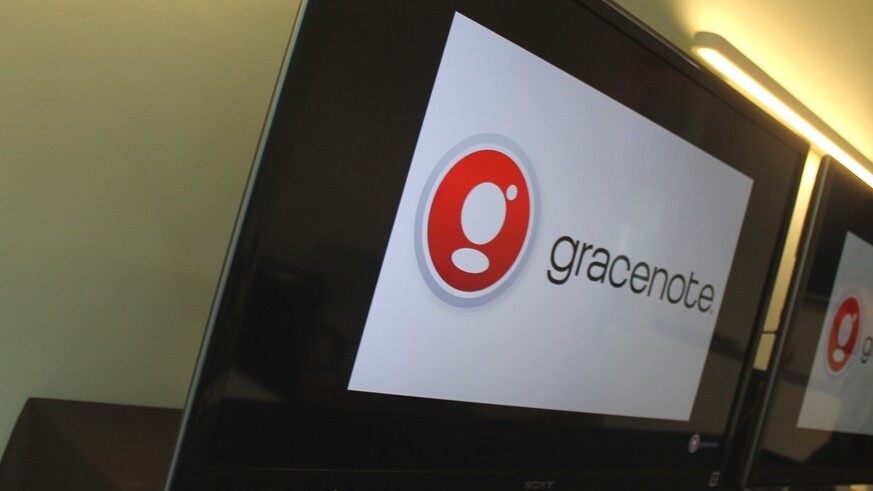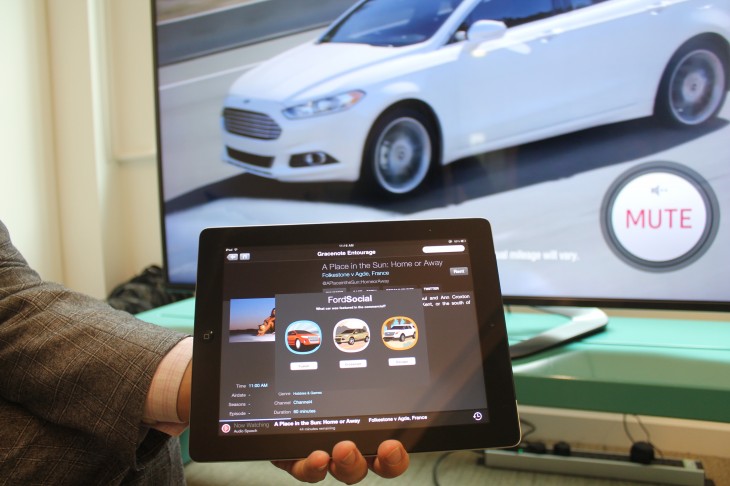
Founded back in 1998 and acquired by Sony in 2008, Gracenote has established itself at the forefront of the media metadata industry.
While Gracenote may be best known as the company whose music database automatically recognizes tracks you rip from CDs on your computer, it has also provided the data for iTunes Genius, in-car entertainment systems, and even Twitter’s Verified account process for bands and musicians.
Moreover, the California-based company has been making a big push in recent times towards TV and video too, forming partnerships with second screen apps such as Zeebox (based on audio-fingerprinting), before going on to release its video APIs into the developer community. This included elements such as TV listings data and imagery, as well as Automatic Content Recognition (ACR), which basically lets mobile devices identify and sync with TV programs and movies.
Watching a Ford commercial on TV? A second screen app powered by Gracenote can detect this and throw up relevant messaging on the screen. It just knows.

Indeed, it’s all very smart, futuristic stuff, but one element in particular stands out as being particularly ‘wooaah’, and that’s ad replacements.
It’s also racking up the TV manufacturer partnerships, recently penning a deal with LG to power its smart TV interfaces across Europe, and it’s by getting inside your TV where Gracenote hopes to take TV advertising to the next level.
And that’s the crux of the proposition. Advertisers have never really been able to properly target ads through the medium of TV, but as we’ve seen in the online sphere, through tracking and tapping user data it’s possible to deliver personalized adverts – this is something that’s now gearing up to infiltrate TV advertising too.
The company first announced its ambitions for so-called ‘ad replacements’ last year, before going on to demo the concept at CES in January. In a nutshell, ad replacement is all about broadcasting ads tailored to the individual watching it. So, for example, a 35-year-old man who owns a BMW might be more interested in adverts on prestigious cars, than a 21-year-old student would be.
Video fingerprinting
The so-called video fingerprinting all takes place inside the TV – so we’re not talking second screen, or third-party apps here. It goes on in the background without the user really knowing about it. It can of course fit in to the bigger second screen picture.
“It’s frame accurate, so we know exactly what’s being watched, and where you are inside that programme,” explained Stephen White, President of Gracenote. “We can then do a couple of things – the first at a basic level is just to profile the user and understand what they’re watching. We can start to look at the content that’s being consumed, and based on the content, we can understand a bit more about the household.”
For example, if you have cartoons on at 10am every weekday, you probably have kids that aren’t of school-age yet. Or if there’s sports on 24-hours a day, chances are you’re 20-year-old guy without a job. Roughly speaking, of course.
Feeding into this, they can also serve up interactive overlays, which are basically little pop-ups that offer fresh real estate for broadcasters to get a message across. This could be ad-based, for example a test-drive at a local car dealership may surface while a BMW advert is airing. But it could equally be used by news outlets to ask the public to respond to surveys or questions around key events and stories.
Then there’s full-on ad replacement.
This is where all the profile data is used, and combined with information that is gathered when the user registers their smart TV, “…which happens at an alarmingly high rate, something like over 80% of people register their smart TVs,” says White.
The secret sauce, however, is the ad-decisioning engines from the likes of INVIDI, which determine if there is better and more-appropriate ads for the user. If there is, the existing ad will be replaced, delivered over the Internet directly to the TV. As far as the end-user is concerned, the experience is seamless, which may actually lead to some interesting conversations at work the morning after the Super Bowl.
Bob: “Did you see that awesome Chevrolet advert after that final Touchdown?”
Bill: “I’ve no idea what you’re talking about, but the Skittles ad was amazing.”
The depth of the profiling is actually quite startling. Advertisers can target, for example, a multi-person household, with an income of $250,000, that owns a Volkswagen Golf. The ad-decisioning engines can tap a lot of information you may not have realized was in public databases, such as whether you’re a homeowner or renter, and what kinds of credit cards you have.
(A)D-day: So when’s this happening?
All the partnerships necessary to make this possible are currently being finalized. Gracenote’s working with the TV set manufacturers to embed the technology within the TVs, and the broadcasters have been brought on board too, which are obviously needed to support the selling of the advertising.
Live trials will be starting in the US very soon – this year – with European trials commencing in the UK in the summer of 2014. The actual full launch of this technology should happen by the winter of 2014 in the US, and in the UK some time in 2015.
Naturally, this will likely creep many people out. The fact that their own data is being used to tailor adverts towards them in their own home. But this has already been happening on the Web for a while already, so it’s hardly surprising that the same would eventually happen as soon as TVs entered the connected fray.
Targeted advertising is big business, and it’s only going to get bigger. Cardlytics recently brought its transaction-linked bank statement ads to Europe, starting with the UK’s Halifax bank. The concept is incredibly lucrative for banks and other brands, as it enables retailers to display adverts next to specific transactions on an account holder’s bill or statement. So, a card payment to Starbucks, for example, could be used by one of its competitors to run a discount or promotion alongside it. Cardlytics has been offering such advertising to bank customers in the US for a while already.
And Amscreen, one of the most well-known outdoor advertising brands in Europe, has started bringing face-detection to its digital ads, gleaning information such as age, gender and other data for advertisers. This is more about data-gathering than tailoring ads to passers-by, but it’s clear that data will play a huge part of advertising in the future.
While other companies are already personalizing TV ads to some degree, such as BSkyB with Sky AdSmart, Gracenote has the partnerships and data to take targeted TV advertising to livingrooms around the world.
Get the TNW newsletter
Get the most important tech news in your inbox each week.




